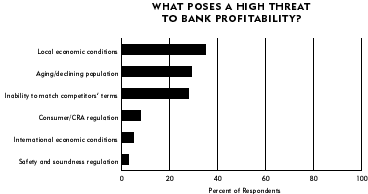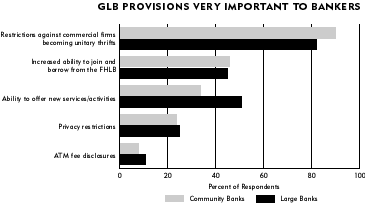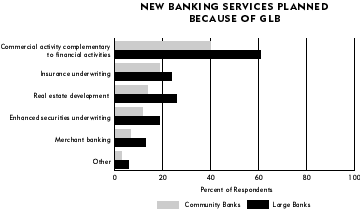"A community bank that does not change with the market will not be around in five years," predicted a Minnesota community banker in the fedgazette's fifth annual banking poll. The Gramm-Leach-Bliley Act (GLB) and the use of technology have intensified the challenges and opportunities faced by district banks. In addition, bankers expect strong local economies, increased investment and more technological innovations. These are the primary conclusions drawn from the fedgazette's poll conducted in February; of 942 banks contacted, 391 responded.
Bankers see opportunities in GLB
Most bankers welcome the changes provided by GLB. Nine of 10 consider the law's restrictions against commercial firms becoming unitary thrifts very important. In addition, almost half the bankers support the increased borrowing capabilities at the Federal Home Loan Bank (FHLB) and over a third think the ability to offer new services and activities is very important.
However, large banks are more likely to offer new services and activities than community banks. Over a quarter of large banks plan to be involved with real estate development compared with 14 percent of community banks. Moreover, three of five large banks will look to commercial activities that are complementary to financial activities compared with only two of five community banks.
As a result of the FHLB's relaxed loan restrictions, half the respondents expect to borrow more from the FHLB. Conversely, only 8 percent of respondents do not plan to use the FHLB for financing.
Although they may find financing more readily available, banks face intense competition from many types of financial institutions. Brokers and securities firms were rated as intense competitors by 56 percent of all respondents and 82 percent of large bank respondents. Community banks are also fierce competitors as 55 percent of all banks noted intense competition coming from this group.
Some banks are concerned about the privacy and ATM fee disclosures brought about by GLB, but privacy disclosures were considered very important by a quarter of respondents, while only 9 percent thought the ATM fee disclosures were very important. A community banker concerned with these disclosures noted, "The excessive amount of regulation in every area of our operation makes banks our size (under $100 million) [unable] to compete not only against large regional banks, but brokerage and insurance companies and large credit unions."
Bankers invest in their future
Even though competition is intense, bankers are optimistic about the economic prospects of their markets. Nearly half the respondents rate market prospects as good, another 14 percent excellent. Large banks are more optimistic: Over three quarters of respondents expect good or excellent economic conditions over the next two years, compared to 58 percent of community banks.
This optimism may lead to more investments in technology. While banks invested heavily in technology and Y2K preparations in 1999, nearly two-thirds of all respondents expect even greater technology investments this year.
Implementing new technologies
District banks are rapidly gaining an Internet presence: 30 percent of respondents indicate that they have a Web site, and 71 percent expect to be on the Web within the next year. Large banks are using the Internet more than community banks: 62 percent currently have Web sites and 91 percent plan to have a Web site within a year. On the other hand, a quarter of community banks are now on the Web, while 68 percent expect to offer a Web site within a year.
Banks are using other technologies as well; 56 percent of respondents offer telephone account inquiries, and 76 percent will provide this service in the next year. Of all responding large banks, 87 percent currently offer this technology compared with about half the community banks. Also, in what may be interpreted as a further sign of the Web's acceptability: The fedgazette asked bankers if they preferred to receive this poll via the Web, and 18 percent responded affirmatively.



Facts about the survey
In February 942 Ninth District banks were surveyed; 391 banks, or 42 percent, responded. Respondents in this analysis have been stratified by asset size. Large banks are considered to have over $100 million in combined assets (55 respondents), while community banks have under $100 million in combined assets (336 respondents).





